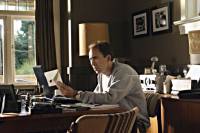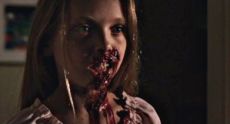
Nicolas Cage suffers for his art in the feeble remake of The Wicker Man
"This situation must be controlled before it's too late. They're multiplying too rapidly!" (Dawn Of The Dead, 1978)
Perhaps Dr Foster had it right: like a gluttonous gaggle of flesh craving zombies, the ever-growing epidemic of the remake is hungrily devouring the canon of classical horror. In an interminable attempt to reinvent the genre, the last three years alone have seen The Texas Chainsaw Massacre, The Hills Have Eyes, Dawn Of The Dead, House Of Wax, When A Stranger Calls, The Fog and The Amityville Horror all undergo a post-millennial Hollywood make-over. The lingering doubts for all the hard-core horror junkies out there will understandably be that, while this new breed of horror is undoubtedly entertaining, has it sacrificed the same originality and sheer fright value of the originals? With this month’s release of Neil LaBute’s take on Robin Hardy’s 1973 shocker The Wicker Man, the question on everyone’s lips will be: haven’t I seen this one before?
 Among the more successful remakes of the past few years is, without question, Zak Snyder’s take on George A Romero’s cult classic Dawn Of The Dead. This is one zombie horror that will definitely catch you, will definitely bite you and you will definitely, definitely love every minute of it. Whereas Romero’s original was a ground-breaking horror as well as a socio-political critique on urban America post Reagan, Snyder focuses on delivering a frenetic assault that marks a clear and bloody line between the original and the remake. The vision of the undead clinging to the comfort of the suburban shopping mall was, in 1978, a direct criticism of the burgeoning commercial and capitalist culture in post-Vietnam America. In 2004, the shopping mall is a well recognised and equally loved aspect of the Americana landscape, leading Snyder to evolve the action and downgrade the characters and plot.
Among the more successful remakes of the past few years is, without question, Zak Snyder’s take on George A Romero’s cult classic Dawn Of The Dead. This is one zombie horror that will definitely catch you, will definitely bite you and you will definitely, definitely love every minute of it. Whereas Romero’s original was a ground-breaking horror as well as a socio-political critique on urban America post Reagan, Snyder focuses on delivering a frenetic assault that marks a clear and bloody line between the original and the remake. The vision of the undead clinging to the comfort of the suburban shopping mall was, in 1978, a direct criticism of the burgeoning commercial and capitalist culture in post-Vietnam America. In 2004, the shopping mall is a well recognised and equally loved aspect of the Americana landscape, leading Snyder to evolve the action and downgrade the characters and plot.
It would be doing Snyder a disservice to say that his DOD is less engaging than Romero’s original; it is merely that the two engage in different ways. Where Romero’s film posed the question: better to be living dead or dead living? Snyder hooks into your nervous system from pretty much start to finish for a terrifying roller-coaster of zombies, guns and explosions. The action makes Snyder’s film an entirely faster and more vicious animal with the survivors even going all A-Team and armouring up a couple of mini-vans to bust open some zombie heads. A truly original remake if ever there was one.
 Among other winning reinventions of recent years Alexandre Aja’s homage to Wes Craven’s 1977 freak-fest The Hills Have Eyes ranks high in being able to make a blood-stained butcher blub like a baby. Having delivered the twisted Switchblade Romance Aja is a virtual connoisseur of shock horror and it doesn’t get more shocking or horrible than Craven’s original. With previously unseen levels of ultra-violence and depravity the original picture teetered along the fragile boundary line between being gross and outright perverse. Never one to shirk at a challenge, Aja succeeds in filling Craven’s rather misshapen and morally bankrupt boots with cutting aplomb.
Among other winning reinventions of recent years Alexandre Aja’s homage to Wes Craven’s 1977 freak-fest The Hills Have Eyes ranks high in being able to make a blood-stained butcher blub like a baby. Having delivered the twisted Switchblade Romance Aja is a virtual connoisseur of shock horror and it doesn’t get more shocking or horrible than Craven’s original. With previously unseen levels of ultra-violence and depravity the original picture teetered along the fragile boundary line between being gross and outright perverse. Never one to shirk at a challenge, Aja succeeds in filling Craven’s rather misshapen and morally bankrupt boots with cutting aplomb.
In terms of striving to capture the ambience of the original vision, Aja succeeds in tapping into the raw throbbing nerve of obscenity that characterised Craven’s film. If possible, Aja’s recreation is even more lurid, visceral and intense, with some scenes, notably Big Bob going down in a blaze of glory, leaving a foul taste in the mouth that even your Orange Tango won’t wash out. For virtually the entire running time of the film the innocent family are besieged by nasties, making the innocuous Doug’s sudden transformation into an axe-wielding nut case a real high point. Aja’s film offers something gruesomely new to an audience with high expectations, making this film a contender for the moniker of best ever horror remake.
In saving the ‘best’ until last we come upon the most famous horror remake of all time, terrifyingly loathsome in all its flesh-tingling glory: The Texas Chainsaw Massacre. In attempting to recreate the inimitable fear of Tobe Hooper’s 1974 film, the colossal genius Michael Bay decided to go with music video aficionado Marcus Nispel who, having worked with Cher and Janet Jackson, has seen his fair share of horror.
Hooper’s original film was a landmark in the horror genre; its gritty and relentless pace cut a deep swathe through audiences that lapped up its almost coronary inducing energy. In terms of remaking a horror movie, or any film in general, this picture is a cult classic. The iconic image of Leatherface violently swinging his buzzing chainsaw is forever etched in the unconscious of a generation of horror movie lovers. Bay’s remake proved better than expected but was very much MTV horror and lacked the impetus that made the original such a marvel. The picture perfect cast get mutilated in truly bizarre and innovative ways but the violence and gore feels very contrived. Where the original felt like a shocking documentary, the remake has all the perfunctory poise of Hollywood making it one of the disappointments in Hollywood’s growing list of horror remakes.
In terms of casualties and contenders, the inventive panache of Snyder and Aja has given the horror remake real credibility. The adrenal glands of terror junkies across the globe have been punched into overdrive as all the things that bump in the night are bumping a whole lot harder and faster than ever before. While the question mark of originality will be ever-present, films like Dawn Of The Dead and The Hills Have Eyes offer something very fresh and very frightening. As its rebirth continues with the release of LaBute’s The Wicker Man, the horror genre has all the allure of an agonizing afternoon at the multiplex and, let’s face it, that’s all anyone’s really after anyway.





















